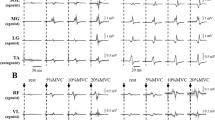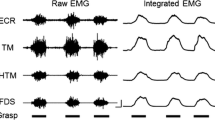Summary
Long latency reflexes were measured from the hand muscles of 27 patients suffering from different cerebellar diseases (12 diffuse cerebellar atrophies, 7 cerebellar hemispheric infarcts, 8 Friedreich's disease) and from 45 controls after electrical stimulus of the median nerve at the wrist. The M3 response (latency about 70 ms) was increased in about 50% of cerebellar atrophy cases and occasionally (10 of 12 cases) separated from the M2 response (50 ms). M3 was sometimes (3/7) increased and the M2-3 complex was prolonged ipsilaterally in cases of cerebellar infarcts. In the cases of Friedreich's ataxia M2 was always lost uni or bilaterally because of the disturbance of afferent or efferent fibres. The latencies of the spinal reflex M1 and also of M2 were not always increased strongly enough to be clearly separated from the normal values.
Similar content being viewed by others
References
Angel WR (1982) Shortening reaction in patients with cerebellar ataxia. Ann Neurol 11:272–278
Barbeau A (1976) Friedreich's ataxia — an overview. J Can Sci Neurol 13:389–397
Bouchard JP, Barbeau A, Bouchard R, Bouchard RW (1979) Electromyography and nerve conduction studies in Friedreich's ataxia and autosomal recessive spastic ataxia of Charlevoix-Saguenay (ARSACS). J Can Sci Neurol 6:185–189
Brooks VJ (1984) The cerebellum and adaptive turning of movements. In: Creutzfeldt O, Schmidt LRF, Willis WD (eds) Sensory-motor integration in the nervous system. Exp Brain Res (Suppl. 9) 170–183
Caruso G, Santoro L, Perretti A, Serlenga L, Crisci C, Ragno M, Barbieri F, Filla A (1983) Friedreich's ataxia: electrophysiological and histological findings. Acta Neurol Scand 67:26–40
Claus D (1986) Long loop-Reflexe — eine klinisch relevante Methode. Fortschr Neurol Psychiatr 54:35–41
Claus D, Aschoff JC (1980) Computer-Tomographie bei Atrophien im Bereich der hinteren Schädelgrube. Arch Psychiatr Nervenkr 229:179–187
Claus D, Aschoff JC (1981) Cranial computerized tomography in spinocerebellar atrophies. Ann New York Acid Sci 374:831–838
Claus D, Aschoff JC (1982) Computertomographische Differentialdiganose infratentorieller Atrophien. Arch Psychiatr Nervenkr 231:289–303
Claus D, Lang C, Kotzian J (1985) Zur Beziehung zwischen Long-loop-Reflexbefund und Topographie von Hirninfarkten. Z EEG-EMG 16:191–195
Conrad B (1978) The motor cortex as a primary device for fast adjustment of programmed motor patterns to afferent signals. In: Desmedt JE (ed) Cerebral motor control in man: Long loop mechanisms. Progress in clinical neurophysiology, vol 4. S. Karger Basel, pp 123–140
Conrad B, Aschoff JC (1977) Effects of voluntary isometric and isotonic activity on late transcortical reflex components in normal subjects and hemiparetic patients. Electroencephalogr Clin Neurophsiol 42:107–116
Darton K, Lippold OCJ, Shahani M, Shahani U (1985) Long-latency spinal reflexes in humans. J Neurophysiol 53:1604–1618
Dichgans J, Diener HC (1984) Clinical evidence for functional compartmentalization of the cerebellum. In: Bloedel JR, Dichgans J, Precht W (eds) Cerebellar functions. Springer, Berlin Heidelberg New York, pp 126–147
Dichgans J, Diener HC, Müller A (1985) Characteristics of increased postural sway and abnormal long loop responses in patients with cerebellar diseases and parkinsonism. In: Struppler A, Weindl A (eds) Advances in applied neurological science. Electromyography and evoked potentials. Springer, Berlin Heidelberg New York, pp 68–74
Diener HC, Dichgans J, Bacher M, Guschlbauer (1984a) Improvement of ataxia in alcoholic cerebellar atrophy through alcohol abstinence. J Neurol 231:258–262
Diener HC, Dichgans J, Bacher M, Guschlbauer B (1984b) Characteristic alterations of long-loop “reflexes” in patients with Friedreich's disease and late atrophy of the cerebellar anterior lobe. J Neurol Neurosurg Psychiatry 47:679–685
Dunn HC (1973) Nerve conduction studies in children with Friedreich's ataxia and ataxia teleangiectasia. Dev Med Child Neurol 15:324–337
Dyck PJ, Lambert EH (1968) Lower motor and primary sensory neuron diseases with peroneal muscular atrophy. II. Neurologic, genetic and electrophysiologic findings in various neuronal degenerations. Arch Neurol (Chicago) 18:619–625
Eccles JC (1982) The future of Studies on the Cerebellum. In: Palay SL, Chan-Palay V (eds) The cerebellum — new vistas. Springer, Berlin Heidelberg New York, pp 607–620
Eccles JC (1977) Cerebellar function in the control of movement. In: Rose F (ed) Physiological aspects of clinical neurology. Backwell Oxford, pp 157–178
Eisen A, Hoirch M, Fink M, Goya T, Calne D (1985) Noninvasive measurement of central sensory and motor conduction. Neurology 35:503–509
Evarts EV, Vaughn WJ (1978) Intended arm movements in response to externally produced arm displacements in man. In: Desmedt JE (ed) Cerebral motor control in man: long loop meachanisms. Progress in clinical Neurophysiology, vol 4, S Karger, Basel, pp 178–192
Fiaschi A, Ferrari G, De Grandis D, Tomelleri G (1978) Involvement of the peripheral nervous system in spino-cerebellar ataxia. Acta Neurol (Napoli) 33:22–30
Friedreich N (1863a) Ueber degenerative Atrophie der spinalen Hinterstränge. Virchows Arch [Pathol Anat] 26:433–459
Friedreich N (1863b) Ueber degenerative Atrophie der spinalen Hinterstränge. Virchows Arch [Pathol Anat] 27:1–26
Friedreich N (1877) Ueber Ataxie mit besonderer Berücksichtigung der hereditären Formen. Virchows Arch [Pathol Anat] 70:140–152
Geoffroy G, Barbeau A, Breton A, Lemieux B, Aube M, Leger C, Bouchard JB (1976) Clinical description and roentgenologic evaluation of patients with Friedreich's ataxia. J Can Sci Neurol 3:279–286
Greenfield JG (1954) The spino-cerebellar degenerations. Blackwell Scientific Publ. Oxford, pp 21–34
Harding AE (1985) The hereditary ataxias and related disorders. Clinical neurology and neurosurgery monographs, vol 6. Churchill Livingstone, London
Harding AE, Thomas PK (1980) Autosomal recessive forms of hereditary motor and sensory polyneuropathy. J Neurol Neurosurg Psychiatry 43:669–678
Hore J, Vilis T (1984) A cerebellar-dependent efference copy mechanism for generating appropriate muscle responses to limb perturbations. In: Bloedel RJ, Dichgans J, Precht W (eds) Cerebellar functions. Springer, Berlin Heidelberg New York, pp 24–35
Hughes JT, Brownell B, Hewer RL (1968) The peripheral sensory pathway in Friedreich's ataxia. Brain 91:803–818
Jones SJ, Baraitser M, Halliday AM (1980) Peripheral and central somatosensory nerve conduction defects in Friedreich's ataxia. J Neurol Neurosurg Psychiatry 43:495–503
Lee RG, Tatton WG (1975) Motor responses to sudden limb displacements in primates with specific CNS lesions and in human patients with motor system disorders. J Can Sci Neurol 2:285–293
Marsden CD, Merton PA, Morton HB (1976) Servo action in the human thumb. J Physiol 257:1–44
Marsden CD, Merton PA, Morton HB, Adam J (1978) The effect of lesions of the central nervous system on long-latency stretch reflexes in the human thumb. In: Desmedt JE (ed) Cerebral motor control in man: Long loop mechanisms. Progress in clinical neurophysiology, vol 4. S. Karger, Basel, pp 334–341
Marsden CD, Rothwell JC, Day BL (1984) The stretch reflex: Human spinal and long loop reflexes (chap 4). In: Shahani BT (ed) Electromyography in CNS disorders: Central EMG. Butterworth, Boston Londen, pp 45–75
McLeod JG (1971) An electrophysiological and pathological study of peripheral nerves in Friedreich's ataxia. J Neurol Sci 12:333–349
Meyer-Lehmann J, Conrad B, Matsunami K, Brooks VB (1975) Effects of dentate cooling on precentral unit activity following torque pulse injections into elbow movements. Brain Res 94:237–251
Miller AD, Brooks VB (1981) Late muscular responses to arm perturbations persist during supraspinal dysfunctions in monkeys. Exp Brain Res 41:146–158
Milner-Brown HS, Stein RB, Lee RG (1975) Synchronization of human motor units: possible roles of exercise and supraspinal reflexes. Electroencephalogr Clin Neurophysiol 38:245–254
Nashner LM, Grimm RJ (1978) Analysis of multiloop dyscontrols in standing cerebellar patients. In: Desmedt JE (ed) Cerebral motor control in man: Long loop mechanisms. Progress in clinical neurophysiology, vol 4. S. Karger, Basel, pp 300–319
Neundörfer B, Claus D (1985) Alkoholbedingte Polyneuropathie. In: Lehmann H-J (ed) Polyneuropathie. Enke Verlag, Stuttgart, pp 72–79
Noth J, Matthews HR, Friedemann HH (1984) Long latency reflex force of human finger muscles in response to imposed sinusoidal movements. Exp Brain Res 55:317–324
Nuwer MR, Perlman SL, Packwood JW, Kark RAP (1983) Evoked potential abnormalities in the various inherited ataxias. Ann Neurol 13:20–27
Oh SJ, Halsey JH (1973) Abnormality in nerve potentials in Friedreich's ataxia. Neurology (Minneapolis) 23:52–54
Ouvrier RA, McLeod JG, Conchin TE (1982) Friedreich's ataxia. Early detection and progression of peripheral nerve abnormalities. J Neurol Sci 55:137–145
Pelosi L, Fels A, Petrillo A, Senatore R, Russo G, Lönegren K, Calace P, Caruso G (1984) Friedreich's ataxia: clinical involvement and evoked potentials. Acta Neurol Scand 70:360–368
Peyronnard JM, Bouchard JP, Lapointe L, Lamontagne A, Lemieux B, Barbeau A (1976) Nerve conduction studies and electromyography in Friedreich's ataxia. J Can Neurol Sci 3:313–317
Salisachs P, Codina M, Pradas J (1975) Motor Conduction Velocity in Patients with Friedreich's ataxia. Report of 12 cases. J Neurol Sci 24:331–337
Sauer M (1980) Somatosensible Leitungsmessungen bei neurologischen Systemerkrankungen. Neurale Muskelatrophien und spinocerebelläre Ataxien. Arch Psychiatr Nervenkr 228:223–242
Sasaki K (1984) Cerebro-cerebellar interactions and organization of a fast and stable hand movements: cerebellar participation in voluntary movement and motor learning. In: Bloedel RJ, Dichgans J, Precht W (eds) Cerebellar functions. Springer, Berlin Heidelberg New York, pp 70–85
Strick PL (1978) Cerebellar involvement in “volitional” muscle responses to load changes. In: Desmedt JE (ed) Cerebral motor control in man: Long loop mechanisms. Progress in clinical neurophysiology, vol 4. S Karger, Basel, pp 85–93
Tatton WG, Lee RG (1975) Evidence for abnormal long-loop reflexes in rigid parkinsonian patients. Brain Res 100:671–676
Thach WT (1978) Single Unit studies of long loops involving the motor cortex and cerebellum during limb movements in monkeys. In: Desmedt JE (ed) Cerebral motor control in man: Long loop mechanisms. Progress in clinical neurophysiology, vol 4. S Karger, Basel, pp 94–106
Tyrer JH (1975) Friedreich's ataxia. In: Vinken PJ, Bruyn GW (eds) Handbook of clinical neurology, vol 5. North Holland Publ., Amsterdam Oxford, pp 319–364
Wiesendanger M, Miles TS (1982) Ascending pathway of low-threshold muscle afferents to the cerebral cortex and its possible role in motor control. Physiol Rev 62:1234–1270
Author information
Authors and Affiliations
Rights and permissions
About this article
Cite this article
Claus, D., Schöcklmann, H.O. & Dietrich, H.J. Long latency muscle responses in cerebellar diseases. Eur Arch Psychiatr Neurol Sci 235, 355–360 (1986). https://doi.org/10.1007/BF00381004
Received:
Issue Date:
DOI: https://doi.org/10.1007/BF00381004




